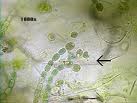Azolla is a small aquatic fern (usually 1-5 cm large) which grows on saturated or moist soil.
It is capable of doubling its weight in 3-5 days. Azolla contains 4.0 percent of nitrogen on a dry weight basis (dry weight is 5 percent of fresh weight); 0.5-0.9 percent of phosphorus; and 2.0-4.5 percent potassium.
A blue green alga (Anabaena azollae) lives in the cavities of Azolla leaves and fixes nitrogen from the atmosphere. The daily nitrogen fixing rate if the Azolla-algae complex is 3 to 7 kg. of nitrogen per hectare.
Azolla has been used by Northern Vietnam and Southern China as source of organic fertilizer for their rice as early as 11th century. Azolla is an excellent source of nitrogen for rice which can eliminate or cut down use of chemicals. It can boost yield equivalent to that produced by 30 to 60 kg. nitrogen fertilizer per hectare.
Residual soil nitrogen is increased and protein content of the grain is also increased. Azolla increase available potassium by absorbing water soluble potassium from irrigation water and returning it into the soil upon incorporation.

 The large amount of biomass produced (10-15 tons per hectare per incorporation) increases soil organic matter (OM) content dramatically, improving soil physical structure and increasing phosphorus availability.
The large amount of biomass produced (10-15 tons per hectare per incorporation) increases soil organic matter (OM) content dramatically, improving soil physical structure and increasing phosphorus availability.
The organic matter from Azolla also contains micro nutrients. An optimum Azolla cover between the rice plants reduces weed growth by 50 percent or more and it can be a good compost material.